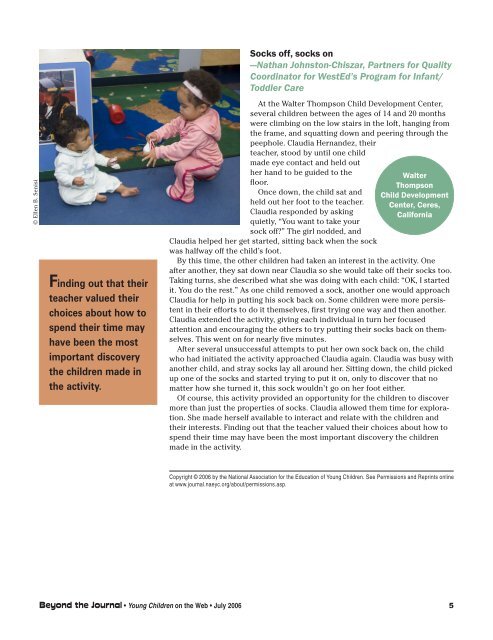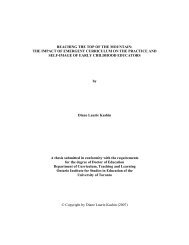Emergent Curriculum for Infants and Toddlers
Create successful ePaper yourself
Turn your PDF publications into a flip-book with our unique Google optimized e-Paper software.
© Ellen B. Senisi<br />
Finding out that their<br />
teacher valued their<br />
choices about how to<br />
spend their time may<br />
have been the most<br />
important discovery<br />
the children made in<br />
the activity.<br />
Socks off, socks on<br />
—Nathan Johnston-Chiszar, Partners <strong>for</strong> Quality<br />
Coordinator <strong>for</strong> WestEd’s Program <strong>for</strong> Infant/<br />
Toddler Care<br />
At the Walter Thompson Child Development Center,<br />
several children between the ages of 14 <strong>and</strong> 20 months<br />
were climbing on the low stairs in the loft, hanging from<br />
the frame, <strong>and</strong> squatting down <strong>and</strong> peering through the<br />
peephole. Claudia Hern<strong>and</strong>ez, their<br />
teacher, stood by until one child<br />
made eye contact <strong>and</strong> held out<br />
her h<strong>and</strong> to be guided to the<br />
floor.<br />
Once down, the child sat <strong>and</strong><br />
held out her foot to the teacher.<br />
Claudia responded by asking<br />
quietly, “You want to take your<br />
sock off?” The girl nodded, <strong>and</strong><br />
Claudia helped her get started, sitting back when the sock<br />
was halfway off the child’s foot.<br />
Walter<br />
Thompson<br />
Child Development<br />
Center, Ceres,<br />
Cali<strong>for</strong>nia<br />
By this time, the other children had taken an interest in the activity. One<br />
after another, they sat down near Claudia so she would take off their socks too.<br />
Taking turns, she described what she was doing with each child: “OK, I started<br />
it. You do the rest.” As one child removed a sock, another one would approach<br />
Claudia <strong>for</strong> help in putting his sock back on. Some children were more persistent<br />
in their ef<strong>for</strong>ts to do it themselves, first trying one way <strong>and</strong> then another.<br />
Claudia extended the activity, giving each individual in turn her focused<br />
attention <strong>and</strong> encouraging the others to try putting their socks back on themselves.<br />
This went on <strong>for</strong> nearly five minutes.<br />
After several unsuccessful attempts to put her own sock back on, the child<br />
who had initiated the activity approached Claudia again. Claudia was busy with<br />
another child, <strong>and</strong> stray socks lay all around her. Sitting down, the child picked<br />
up one of the socks <strong>and</strong> started trying to put it on, only to discover that no<br />
matter how she turned it, this sock wouldn’t go on her foot either.<br />
Of course, this activity provided an opportunity <strong>for</strong> the children to discover<br />
more than just the properties of socks. Claudia allowed them time <strong>for</strong> exploration.<br />
She made herself available to interact <strong>and</strong> relate with the children <strong>and</strong><br />
their interests. Finding out that the teacher valued their choices about how to<br />
spend their time may have been the most important discovery the children<br />
made in the activity.<br />
Copyright © 2006 by the National Association <strong>for</strong> the Education of Young Children. See Permissions <strong>and</strong> Reprints online<br />
at www.journal.naeyc.org/about/permissions.asp.<br />
Beyond the Journal • Young Children on the Web • July 2006 5


















